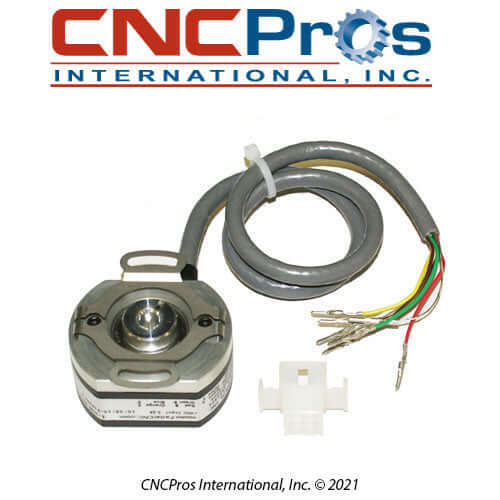ENC-0004 FADAL SPINDLE ENCODER. ACCUCODER
ENC-0004 FADAL SPINDLE ENCODER. ACCUCODER
Couldn't load pickup availability
Share

ENC-0004 FADAL SPINDLE ENCODER. ACCUCODER
ENC-0004 FADAL SPINDLE ENCODER. ACCUCODER
Product Features
Technical Overview:
Fadal Spindle Motor Encoder (ENC-0004)
The ENC-0004 is a 1000-line Accu-coder, serving as a genuine OEM spindle motor encoder for Fadal CNC machines.1 This component is essential for precision motion control, as it monitors spindle rotation with high resolution to ensure accuracy and efficiency in machining operations.2
Operational Functionality
With a 1000-line resolution, the ENC-0004 provides precise, high-fidelity feedback on spindle rotation.3 This enables the CNC controller to maintain a tight feedback loop, ensuring exact control over spindle movements and contributing to enhanced accuracy and quality in machining processes.4 The encoder is designed as a direct replacement part for all Fadal CNC spindle motors.5
Diagnosing a Faulty Spindle Encoder
A failing spindle motor encoder is a common cause of issues with Fadal Spindle Drives operating in Vector mode.6 Missing encoder pulses can lead to miscalculations, causing the drive to output excessive current to the motor. This often manifests as a "pegged" or pulsating load meter and unstable RPMs. A drive may be incorrectly diagnosed as faulty when the root cause is actually the encoder.7
Encoder Testing Procedures
- Oscilloscope Method: The most reliable method for testing the encoder is to use an oscilloscope to analyze the A and B channels.8 This allows for easy detection of pulse errors.
- Baldor H2 Drive Diagnostics: With the new Baldor H2 drive, you can switch to open-loop Inverter mode and use the drive's diagnostic feature to observe erratic changes in the calculated RPM. On older Baldor drives, the drive keypad will display the calculated RPM as you rotate the spindle.
- Multimeter (AC) Method: A simple test can be performed using a multimeter set to AC voltage. When measuring between the encoder's supply power common and one of the A/B encoder signal lines (A+,A−,B+,B−) while rotating the spindle at orientation speed, you should observe approximately 2.8 VAC. The digital pulses are interpreted as an AC voltage by the meter.
- Multimeter (DC) Method: For a more detailed test, use a multimeter on the DC setting. Measure from the encoder's supply power ground to an encoder input line (e.g., A+). The signal should be either high (~3.5 VDC) or low (~0 VDC). The positive and negative channels of each pair (A+ and A−, or B+ and B−) must always be in opposite states. Rotating the spindle and observing the state changes confirms functionality.
CNCPros Support and Warranty
Our commitment to quality extends beyond the product itself. The ENC-0004 comes with a 1-year warranty covering manufacturing defects and performance issues. Our support team is composed of technical experts with deep knowledge of Fadal systems, ready to assist with installation, troubleshooting, and any inquiries to ensure you get the most out of this critical component.
When you choose CNCPros, you are not just getting a high-quality, OEM-compliant part, but also a dedicated support system built on years of experience with Fadal machinery.
Troubleshooting
How to Check Your Fadal VMC Spindle Encoder
Here is a simple, step-by-step guide to checking if your Fadal VMC encoder is working correctly.
A key sign that an encoder is starting to fail is when you see the spindle RPM surge up and down and the load meter spike. This happens because the encoder is sending a bad signal to the machine control.
The best way to test the encoder is with a tool called an oscilloscope, which lets you see the electrical signals. A simple voltmeter can't show you all the details you need to know.
What the Encoder Does
The encoder sends three signals to the Fadal control:
- Channels A and B: These two signals tell the control how fast and in what direction the spindle is spinning.
- Index Pulse (Z Channel): This is a single signal that tells the control when the spindle has completed one full turn.
The Best Way to Test (Using an Oscilloscope)
- Turn off the machine. Unplug the encoder's cable.
- Connect the oscilloscope to the wires for Channels A and B.
- Slowly turn the spindle by hand.
- Look at the screen. You should see two clean, even square waves that look a little out of sync with each other. The voltage should be a steady 0V to 5V.
If you see no signal, the encoder is likely broken or has no power.
If the signals are messy or jumpy, the encoder is probably misaligned or damaged.
If the signals aren't properly "out of sync," the machine will get confused about the direction of rotation.
A Basic Test (Using a Voltmeter)
This method can tell you if the encoder is completely dead, but not if it has a smaller problem.
- Turn off the machine.
- Connect your voltmeter to the encoder's power wires to make sure it's getting 5V.
- Connect the voltmeter to the signal wires for Channels A and B.
- Slowly turn the spindle by hand. You should see the voltage go up and down. If you see no change, the encoder is likely broken.
Using the Fadal Machine's Own Tools
You can also use the Fadal control to help diagnose a problem:
- Check for alarms. Look for any alarms related to the spindle's speed or position.
- Try Spindle Orientation. In the MDI screen, run the command M19. If the spindle doesn't lock into position consistently, the encoder is probably the problem.
- Swap it out. If you have another encoder on a different axis that is the same part, you can temporarily swap them. If the problem moves with the encoder, you've found the issue.
